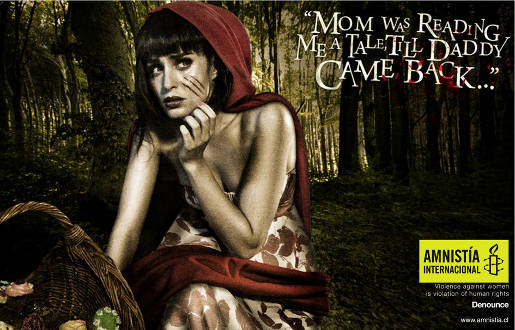Looking at this image it quite quickly becomes clear that what we are being presented with is not the typical fairy-tale image one might find in the pages of a beloved children’s book. We become aware almost instantaneously that this is a domestic violence ad campaign. But what is it about the image that causes us to recognise this and interpret it in that way? Is it the fact that little red appears to be a middle- aged women, or maybe it’s the scratches from the “big- bad wolf” on her cheek or the fearful expression on her face? Or perhaps the blood stained conventional storybook text? The answer? All of these…combined together… to make a beautiful cake of semiotics.
But what is semiotics I hear you ask? Let me break it down for you. Defined most simply Semiotics is the science of signs and the meaning their interpretation elicits (Turnbull 2015).In the study of semiotics, there are two parts to any sign or image; the signifier (or denotation) which is what we see at face value, and the signified (or connotation) which is what the viewer interprets about the image, which thus allows them to form meaning of the sign or image.
However where this gets interesting is that an individual’s perception, changes the way in which they interpret the image or sign, based on their own ideologies and understanding of what they perceive the world around them to be (Turnbull 2015 ) . Chandler provides an accurate definition of this phenomenon in saying “the term ‘connotation’ is used to refer to the socio-cultural and ‘personal’ associations (ideological, emotional etc.) of the sign…Signs are more ‘polysemic’-more open to interpretation- in their connotations than their denotations” (Chandler 2014).The clearest example of this is the colour red. Many meanings can be interpreted from it ie. Passion, romance, anger, lust, luck. However when we place the colour red with a street sign, its meaning is transformed and it is universally understood that it means to stop. (Turnbull 2015).

So in looking back to the image above the signifier is a woman in a red hood, crouching in the forest with scratches on her face. It’s not a particularly pleasant image is it? But once the connotations are then drawn from it and meaning associated with the image it becomes a powerful, evocative advertisement. To begin with the blood stained text “mum was reading me a tale until daddy came back…” is clearly written from the perspective of a young child, alluding to innocence and the destruction of that innocence when domestic violence is involved.
These few words aim to evoke a strong emotional response in the reader and encourage them to engage with the advertisement. Furthermore the font used is that of a conventional story book which relates directly both to the text and image presented within the advertisement. This image is a clear depiction of the fairy- tale “Little Red Riding Hood”. Was this a deliberate decision by Amnesty International? It is well known that the villain in Little Red Riding Hood is the Big Bad Wolf, who is generally stereotyped as a male character. In this images context however the Big Bad wolf becomes the father, demonstrated again through the text and by the scratch marks on the mother’s cheek and fearful expression.
When the concepts of semiotics are applied to this image, its meaning is transformed. However this advertisement is somewhat reliant on the fact that people know the story of Little Red Riding Hood, which further demonstrates the notion that interpretations rely on previous understanding of context. If this image was shown to someone with no knowledge of the fairy- tale it is possible they may perceive the image in an entirely different way. It’s kind of similar to when you quote a movie…. And no-one understands your reference… and you die just a little bit inside. 😛
So now as you go about living your life and doing whatever it is you do, know that every text, sign or image you see has a meaning behind it, and what is it that helps you determine this meaning? Semiotics.
If you are interested here are some other interesting domestic violence advertisement campaigns which utilize the concepts behind semiotics.
-Lizzellbee 🙂
References:
Eyzaguirre,J 2009, Little Red Riding Hood, advertisement, Amnesty International, viewed 18 April 2015 < http://adsoftheworld.com/media/print/amnesty_international_red_little_tender>
Turnbull, S 2015, ‘Lecture Week 3: The Image Cannot Lie’, lecture content, BCM 110, University of Wollongong, March 17 2015.
Chandler, D 2014, Semiotics for Beginners, visual-memory.co.uk, viewed 16 April 2015, < http://visual-memory.co.uk/daniel/Documents/S4B/sem06.html >
Riley, A (tumblr user), STOP sign, GIF, Tumblr, Viewed 19 April 2015 <https://www.tumblr.com/search/stop+sign+gifs>

